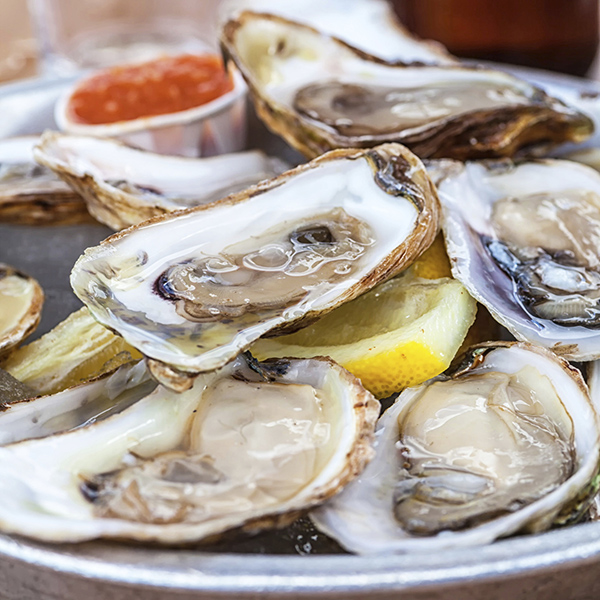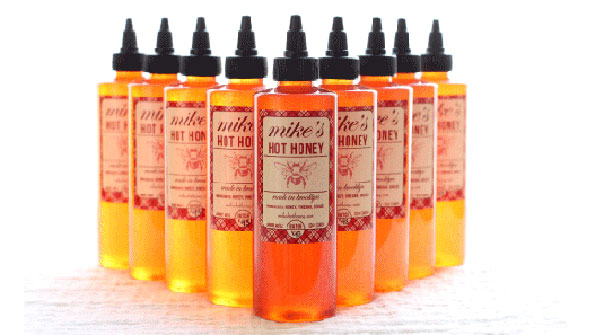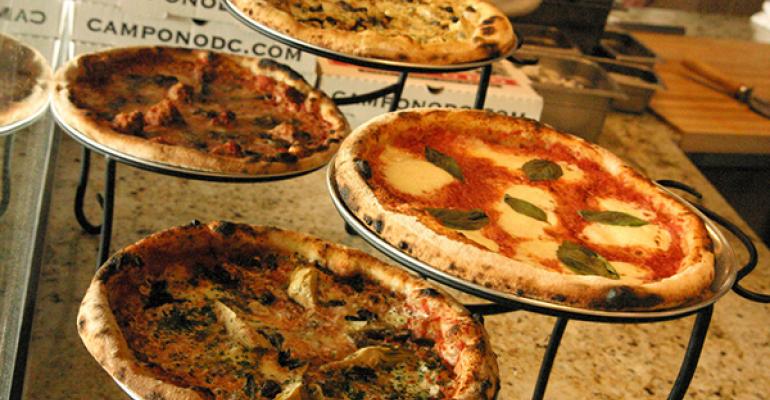Three megatrends rise to the top of the 11 hottest food and beverage trends to come out of Baum+Whiteman’s think tank: how technology is reshaping restaurants, how chefs and manufacturers are finding new ways to combine basic flavors and, thanks to the first two developments, how authenticity is becoming a nonstarter.
Baum+Whiteman, known for creating high-profile restaurants for hotels, restaurant companies, museums and other clients, just released its predictions for next year. Here’s a condensed version of the consultants’ picks; the complete report, including 22 buzzwords, is available here.
1. Tech: The trend of 2015-2016
Forget cronuts and negronis. Forget quinoa and kale. Short of putting food into our mouths, technology is upending the way dining out works. Guest-facing technology, especially tablet ordering and mobile payments, is revolutionizing the dining experience.
That’s good news for restaurant operators. Tables turn faster by eliminating downtime during which little happens and customers start fidgeting. Even that's not efficient enough: Skip the tablet and let people reserve a table and preorder dinner from a mobile device that also tracks how long it'll take to get to a restaurant, and then clues the host and the kitchen to prepare for liftoff. Think of a chef's joy in knowing that 20 minutes hence a party of six will want three ravioli orders (one gluten-free, one high-fiber), two orders of calamari (one fried, one grilled) and one plate of locally sourced root vegetables.
Coming: Amazing new uses for wearables like Google Glass. With face-recognition software, a server can know them names of everyone at a table. And just wait for the avalanche of data that will emerge from ApplePay and other electronic wallets.
2. Prepaid, firm dinner commitments
Restaurants with reservations backlogs are inching toward tech-enabled pay-for-tables systems, selling "tickets" for dinner, often nonrefundable, just like seats on an aircraft. Restaurants get paid before dinner; even before buying food, which enhances cash flow and cuts out excessive inventory because they've always got a guaranteed house count.
Even more: Using yield-management or revenue-maximizing software common in hotels and airlines, restaurateurs can introduce "surge pricing," with menus varying by levels of demand. Would it be possible that the fellow sitting next to you paid only $34 for your $56 steak because he reserved earlier? Did he get a booth while you got a miserable table because he cashed in some frequent diner points than you don't have? Might restaurants auction off their seats to the highest bidders?
The downside? Customers might start loathing restaurants the way they detest airlines.
Restless palate syndrome
3. Oystermania
We've rediscovered oysters. They're cheap because bays, inlets and tidal basins are being detoxed, so farmers are reseeding old oyster beds and discovering new ones. Not a few here and there, but dozens around the country.

Chips and pretzels are disappearing as happy hours on the coasts keep booze flowing with dollar-apiece oysters. Mixologists and sommeliers scramble for steely white wines and new cocktails to match the bivalves. Locavores and farm-to-tableniks love the notion of plucking these critters from nearby waters, while sophisticates guess by brine, acidity and shape where an oyster's from, giving rise to the term "merroir" as a parallel to wine-related "terroir." (There's even a shellfish place in Virginia called Merroir, which must be hell to pronounce down there.) At Waterbar in San Francisco, oyster descriptors include: tropical fruit finish; clean lettuce finish; touch of bitter herb; honeydew melon; sweet grass.
4. Restless palate syndrome
We can't let well enough alone. New flavors, new products, radical mashups are pouring out of restaurants and food labs, and any semblance of authenticity goes out the window. Here's how we're feeding the country's restless palate syndrome:
Beyond kale: Celery root, parsnips, kohlrabi and other ugly root vegetables are grabbing attention in restaurant kitchens. Fried, mashed, pureed, gratineed; flavored with cured pork or smoked honey, these humble roots replace humble potatoes, but with lots more inherent flavor.
Seaweed beyond sushi: Seaweed may not be the next kale, but it's on the upslope of the trendline. Consumers recognize it as a packaged snack and as a California roll's wrapper. But chefs are adding it (often silently) to poaching broths, seafood sauces, even risotto, for its punch of umami and evanescent background flavor and dash of salinity

Beyond sriracha: Look for lots more sweet-spicy sauces and condiments. Chefs and big restaurant chains are experimenting with piquant honey: habanero honey, jalapeno honey and ghost chili honey, ginger-citrus honey ... going on chicken-and-waffles, whipped into butter, mixed into salad dressings, snuck into sauces. Same thing with jams and jellies. Revered Paulie Gee's in Brooklyn spreads its already hot sopressata pizza with chili honey, getting lots of press for its efforts.
Beyond sweetened yogurt: Health-crazed consumers gorge on fruit-flavored yogurt, ignorant to the fact that they're often ingesting candy-level calories. Now we have vegetable yogurt, tomato yogurt, kimchee yogurt, yogurt with hummus and more, healthier varieties.
Beyond salsa: Hummus without borders: You've watched the rise of Greek yogurt. Now hummus—once a niche product here eaten primarily by Arab and Israeli immigrants—Is following the same trajectory. Google says that hummus has out-trended salsa, no small thing since salsa dethroned ketchup. The chickpea dip has become so Americanized (i.e., piled with flavorings) that Subway is testing it as a no-meat option for sandwiches. Hummus is high in protein and fiber and low in fat, so it touches lots of dietary bases. Eight years ago perhaps 12 percent of U.S. households had it in the fridge; today that figure is 20 percent and rising. Upscale supermarkets display two dozen variations: beet, pumpkin, Thai chili, spinach-artichoke, guacamole, edamame, cilantro-chimichurri, lemongrass-chili even (oh, dear) chocolate mousse. Another example of why "authenticity" is on the downswing.
Beyond bacon: After despoiling ice cream sundaes and whisky cocktails with bacon, the bizarre fixation on everything bacon seems to have abated. But not so for all things pork, though. More guanciale, more pancetta, more fried ears, more cheeks, and then there's 'ndjua (not a typo), a light-up-your-mouth spreadable sausage from Calabria made, originally, from unmentionable parts of the pigs, now finding its way onto pasta, melting over pork chops, spiking mushrooms over focaccia, even blended into vinaigrettes as sauces for fish. If bold flavors are a trend, this eye-stinging, red-peppered sushy salami is next year's bold flavor.
Let toast be toast: Free us from $4-and-up slices of "artisan toast!" For example: "hand-crafted 12-grain bread sliced to order and bronzed over an oak fire, then spread with organic beach plum jelly harvested by genuine hipsters and topped with pink Himalayan sea salt ground a la minute" ... despite all those words it still is just toast and jelly. Toast used to come with your eggs and cost nothing. Now toast claims it own space on menus of coffee houses, cafes and bruncherias. Some have sprawling toast menus: Toast Ballard in Seattle has 13 offerings; Sqirl in L.A. gets $7 for Burnt Brioche Toast with house ricotta and seasonal jam.
Shifts in beverages
5. Big shifts in alcoholic beverages
Shareable punches: Your parents' preference for communal boozing is back. Now liberated mixologists in fancy places are concocting large-format punches that serve multitudes of guests, with no limits on pricing or ingredients.
At Rickhouse in San Francisco, $50 gets you a punchbowl of eight-year-old rum, lemon juice, Peychaud's bitters, ginger beer and Amaro CioCiaro (see Herbal Liqueurs, below). The ultimate, at NY's NoMad Bar, comes in a spigot jar with a cup of top-shelf cognac, an equal amount of Royal Combier liqueur, lemon juice, Demerara syrup, bitters, half a dozen lemons, a fistful of mint and lots of ice. It costs $110. Sugar Factory in various locations boasts a big list of 60-ounce shareables, including a watermelon vodka punch with a Red Bull floater. All eminently festive and communal. But they don't have to be so complex. After all, what's sangria if not a punch?
Herbal liqueurs: Mysterious ancient blends of botanicals—Flowers, spices, citrus peels, herbs, shrubs, tree barks—are new again to new generations of drinkers. What once were standalone before- or after-dinner drinks—chartreuse, maraschino, Benedictine, and, especially, absinthe—are now adding body and depth to inventive cocktails.
Whackadoodle hybrids: Spirits manufacturers, pandering to Millennials and women, are sweetening name-brand brown whiskies with honey or maple syrup or flavoring them with cinnamon, apples, ginger, vanilla, cherries, even pumpkin pie spices (inspired, one guesses, by Starbucks' pumpkin spice latte). They're also trying to lure drinkers away from flavored vodkas, which are hitting a wall of boredom these days. About 40 percent of all spirits here have added flavorings. Equally deviant are shotgun marriages like Malibu Red (rum-tequila), Vodquila (vodka-tequila), Grey Goose's VX (vodka-cognac), Jinzu (gin-sake), Courvoisier Rose (rose wine-cognac), Kahlua Midnight (Kahlua-rum), and Absolut Tune (Sauvignon Blanc-vodka-carbonation in a champagne bottle). These mashups are evidence that the case for "authenticity" in the world of F&B continues weakening year after year. In France, flavored wines (peach, grapefruit, even Coke) are popular with 18- to 34-year-olds, which means the world may indeed be coming to an end.
Soda fountain crashes the bar: Diet-be-damned adults are splashing booze into ice cream favorites. Belmont House of Smoke in Norfolk is semifamous for its Guinness Float. Punch Bowl Social in Denver features Milk-Xologist (coffee liqueur, branca menta, vanilla ice cream, nutmeg); a new 300-seat diner in New York will have a slew of "adult shakes"; Del Frisco in Atlanta offers walnut liqueur, creme de cacao and vanilla ice cream.
Vodka cedes the throne: Brown whiskey has at long last outstripped vodka in sales dollars. Bourbon, rye, blends and Scotch are enjoying a renaissance because drinkers want more body. No one really believes vodka is "crafted," but an explosion in local distilleries around the country specializing in small-batch whiskies is riding the demand for natural, local and authentic...sort of a grain-to-bottle movement. Besides, bourbon and rye are traditional American boozes, and they're more distinctive with lots of variation from brand to brand.
6. Soda and other soft drinks: The landscape is shifting
Spooked by sugar, dubious reputations of alternative sweeteners and greenies waving placards about harmful chemicals, consumers are abandoning traditional soft drinks, not only in the U.S. but in Europe. Aging boomers and skeptical Millennials alike are seeking drinks with healthful halos; never mind whether they're truthfully good for you.
Anything that stood next to a coconut sells readily. "Enhanced" in ways Mother Nature never intended, "premium hydration" ready-to-drink (!) waters fly off food market shelves, proving that H2O on its own is not a soda replacement. But barely sweetened, lightly flavored (frequently artificially) waters attract consumer interest everywhere ... even when carbonated.
Cucumber and coconut waters are so hot that they're being overlaid (or adulterated...take your pick) with flavors like coffee and mango and with energy-boosting ingredients. Now they're talking about maple water and even birch sap. Flavor enhancers could move to other beverages—milk, for example, and more booze products. Little packets of flavor enhancers that fit in your purse now allow you to make everything edible taste like an exaggerated raspberry or a peach bellini.
House-made soft drinks are hot among indie restaurants, slower elsewhere. Chilled specialty teas are hot at fast-casual chains, slower most other places.
Next-gen coffee shops: Pressured by rising real estate, by Starbucks' relentless evolution, and by Dunkin Donuts' fixation on its beverage business, coffee shops will rethink their business models. They've got to fill in downtimes (i.e., most of the day).
Beer and wine sometimes help, but then you need the proper go-withs, so along come limited menus that often don't augment the alcohol experience. The coffee business is moving from the "third place" to maybe a "fourth place."
The future of juicing: Remember the croissant? About 35 years ago, an intrepid entrepreneur imported from France to New York the concept of filled croissants. Within a year, croissant restaurants and croissant restaurant chains were everywhere—until Burger King co-opted the idea by selling a gummy (but popular) Croissan'wich ... demonstrating that anyone could sell a degraded French pastry. Almost immediately, the specialist restaurants began closing their doors, because they were one-trick ponies.
We mention this bit of history because the same thing's happening with juices. Last year we talked about hot investor money moving into the juice biz. Today, everyone knows a healthfoodista who's opening a juice bar. Google "How to Open a Fresh Juice Shop" and you get 14,000,000 links in 0.48 seconds.
Retailers crowd restaurants
7. Clothing retailers and others crowding the restaurant space
Last year this report laid out how retail stores were putting shoppers in their aisles by grabbing restaurant traffic. Now we're looking at boldface fashion names doing the same. The objective? To increase what we call "dwell time": the amount of time a shopper spends on the premises. Statistically, the longer they stay, the more they spend.
Ralph Lauren will have a coffee shop in its new flagship store on Fifth Avenue, plus a restaurant in the old La Cote Basque space. Roberto Cavalli has restaurants in nine stores, Armani lots more.
Urban Outfitters' "Lifestyle Center" in Brooklyn imported from L.A. top-chef Ilan Hall's The Gorbals and plopped it next to menswear, and a megastore in Herald Square will house New York's second Intelligentsia Coffee. Meanwhile, Conde Nast (Vogue, Vanity Fair, GQ) operates restaurants and bars overseas and plans on putting GQ Bars (like one at the Marriott Marquis in Dubai) into London, Paris and New York.
Next big challenge to restaurants: Order-it-today/get-it-today meal kits for easy home cooking, and branded meal delivery services from Google, Amazon and new startups.
8. Chefs ditching four-star dining?
Chefs and restaurateurs are rethinking backbreaking, high-risk commitments to multi-star dining as customers in droves pledge allegiance to the fast-casualization of America. Why worry about critics and bloggers when, like Danny Meyer, you can strike gold with an IPO (pending) for 56-unit-and-counting Shake Shack?
Look at who's aiming to be the next Chipotle: Jose Andres is opening Beefsteak (after the tomato), a veggie-focused fast-casual concept in Washington DC. Top Chef Spike Mendelsohn is franchising his fast-cas Good Stuff Eatery. Chris Jaeckle (A Fiori, All'onda) just opened a fast-cas Brazilian-Japanese sushi joint. Joshua Skenes of San Francisco's Saison (where you can drop $1,000 for dinner for two) is opening Fat Noodle, a Chinese hand-pulled noodle fast-cas, with Adam Fleischman (Umami Burger, 800 Degrees). Bob Kinkead in Washington opened Campono (fast-cas pizza). Brad Ogden is rolling the dice in Houston with the fas-tcas Funky Chicken. There are lots of others.
The end of tipping?
9. Say hello to neurogastronomy
Last year we talked about how forward-thinking restaurants are heightening dining experiences by assaulting all the senses: diffusers oozing aromas of caramel or woodsy mushrooms, hi-def imagery altering the walls of dining spaces (see "I Lost My Dinner in the Funhouse"). Shanghai chef Paul Pairet called it "psychotasting." Turns out there's a more scientific word: neurogastronomy. It's all about how our senses cumulatively react to food, and how to profitably manipulate those senses. Example: Drinks company Diageo learned that a room with real grass and the sounds of birds makes single-malts taste grassier; substitute red lighting and curved furnishings and the drink tastes sweeter; creaking floorboards, a crackling fire and a double bass provide the most pleasurable experience (maybe explains why most bars are darks and woody).
Nestle's labs discovered that the shape of chocolate affects its flavor: Curved rather than angular chocolate bits melt better and release different flavors. Other researchers say food tastes better on heavier china ... that citrus flavors clear the mouth quickly and leave you ready to more ... that hard and rough foods are perceived as having fewer calories and greater health benefits (break out those taco chips) ... that high-pitched music signals sweetness and bass notes suggest bitterness ... that umami works with low-pitched sounds... that loud background noise reduces enjoyment of food (so much for your curated playlist).
10. The death knell for tipping
Social and economic trends move glacially, and then seem to happen all at once. While most people pooh-poohed no-tipping restaurants as un-American, the movement has picked up big, possibly irreversible, momentum. One consequence of selling tickets for dinner instead (see No. 2) is that a service charge (usually 20 percent) is automatically added.
Local governments are passing "living wage" laws, lifting minimum wages, sometimes abolishing tip credits ... raising labor costs for operators. The disparity between earnings of tipped waiters and untipped back-of-house grunts is becoming a moral issue tinged with class warfare. Meanwhile, waiters sue over untipped sidework ( 5,000 bartenders and servers sued Applebee's, demanding minimum wage for untipped hours spent folding napkins) ... and lower-level employees are incensed by how tips are distributed. And governments, grasping for every penny, make accounting for tips, benefits, meals, etc. increasingly complex and costly ... all prompting operators to consider getting rid of tipping and giving everyone a higher hourly wage.
11. Waiter, what's that fly doing in my soup?
We swat them and spray them, but many people on the planet consume insects as a protein source. The conversation about eating bugs is just beginning but it won't go away. We could eliminate lots of greenhouse gasses and cow poop if we found creative ways of using highly renewable creepy-crawlies that can overcome the yuk factor. Insect protein bars already are on the market. And Vij, the Indian restaurant maven in Vancouver, sells a pizza-like paratha topped with crickets. Would you really care if your chips or nachos or tacos were fortified with cricket powder? If your bread got a protein boost from ladybug flour? If your pasta (gluten-free, of course) contained low saturated-fat grasshoppers? Probably you would care, but soon you may find your children scoffing at the amount of nonsustainable food you eat.





